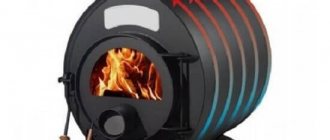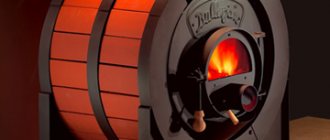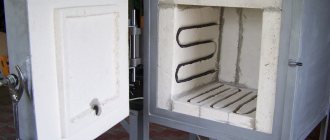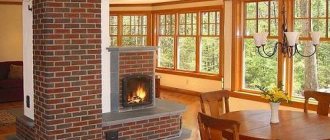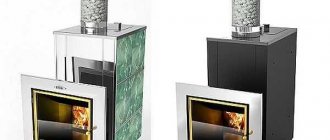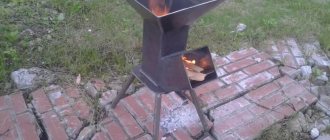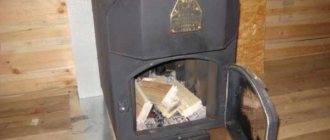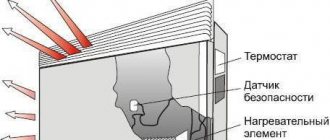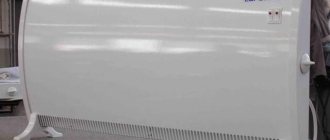How does the Buleryan stove work?
The Buleryan stove is often compared to a potbelly stove and a regular long-burning wood stove. We can say that the device took elements from both.
The operation of the oven is based on the principle of convection. Pipes for heat exchange are connected to the volumetric secondary chamber, in which the process of burning wood occurs. The principle of their operation is very simple. Cold air enters the pipe at the base of the Buleryan stove, and then comes out already heated at the top of the structure.
The furnace body can be of two shapes. For small rooms, cylindrical Buleryan stoves are most often made. For a large heating area, the stove takes on a teardrop shape. Pipes are placed on the outside of the structure. To ensure maximum heat transfer, they are soldered into the structure and protrude by only one third.
Operating principle of the Buleryan stove
The furnace firebox consists of three parts. A grate or fire-resistant mesh is placed at the bottom of the firebox. They can be made of cast iron or steel with a thickness of at least 4 millimeters. There is a special compartment at the top of the firebox. It is obtained thanks to a partition, for the manufacture of which a steel sheet is used. This compartment is also called the secondary chamber. In it, the combustion of gases occurs, which are released during the burning of wood. Combustion of fuel in the furnace itself is not complete. The released combustion products pass into the chimney. The length of the chimney is about 1 meter. Due to this part of the furnace, the combustion process becomes slower, and the combustion products cool down. The chimney is made curved and contains an economizer. Thanks to this device, secondary combustion of gases occurs. This stove structure increases heat transfer by 20% compared to other stoves.
The combustion process of wood is regulated using a damper. The damper is a damper near the exit from the firebox that regulates the intensity of the draft. It is attached to the pipe using a special metal rod. On the door, by changing the position of the gate, you can regulate the intensity of the oven.
Scheme of the Buleryan furnace
The Buleryan stove is enough to heat a room of 100 m3. This will take no more than 3 hours. Large designs of the Buleryan stove are suitable even for heating large rooms, up to 400 m3. Not every oven can cope with such a task.
Keeping warm is also easy. Buleryan is an economical stove that requires adding firewood only twice a day.
Heating with “Buleryan” several rooms
These long-burning units are also used to heat several rooms. To do this, there is no need to remodel or modernize the Buleryan boiler.
You can assemble air ducts and a heat chamber into a single structure. An air heat supply system created in this way is no less effective than a water heat supply system, and the costs of its arrangement are several times less.
To assemble a thermal chamber with your own hands, use ready-made diagrams. In this case, galvanized profiles intended for drywall, as well as galvanized sheets, are used.
A frame is built from the profile, and holes are cut out in sheets of metal for grilles and inspection doors. Then they are attached to the finished frame. The galvanized surface is covered with mineral wool mats. Then the chamber is decorated as desired.
Air ducts are connected to the air outlets located on top. They are made from plasterboard, but you can use metal pipes of the desired diameter or square shape, similar to standard air ducts. This solution is more effective than installing corrugations on heat exchange pipes.
As a result, all the heat produced by the stove accumulates in the thermal chamber, and then it is distributed through the air ducts. When arranging heating with Buleryan, it is necessary to take into account the following nuance - the shorter the air ducts, the more effective the heating of the rooms is.
By the way, some property owners are trying to adapt this stove for water heating. But the principle of its operation and the heating of water do not coincide due to its greater heat capacity compared to air. Therefore, for water heating it is better to install a modern pyrolysis boiler or a long-burning unit of another type.
Advantages and disadvantages of the Buleryan stove
The Buleryan stove was first used by foresters in the Canadian taiga. They needed to carry a compact stove with them, into which it was necessary to rarely add firewood, and also to warm up very quickly from its heat. The Buleryan stove easily coped with this task. Advantages of the Buleryan stove:
- Compactness. A stove capable of heating 100 m3 weighs only 50 kg.
- Fast heating of the room. A small room of 30 m3 can be heated using a Buleryan stove in less than half an hour.
- Low energy consumption. The stove gradually burns wood, so there is no need to frequently add new combustible material to the firebox. It is enough to heat the room once to forget about adding firewood for 10-12 hours.
Despite the fact that the stove is a very well-thought-out design, there are still several disadvantages:
- Soot. Due to the fact that not all combustion products remain in the firebox, the soot goes into the chimney. Because of this, the length of the pipe relative to the furnace must rise at least 3 meters. This may also cause an unpleasant odor during heating.
- The need for constant adjustment. To prevent the temperature in the room from falling and the firewood to smolder slowly, it is necessary to constantly adjust the position of the damper. This requires skill and time.
- Dust combustion. Heat transfer in the Buleryan model occurs from the surface of the furnace. The metal becomes hot, causing the dust that settles on it to burn. Because of this, the air becomes musty and an unpleasant odor may also appear.
Universal Soldier
Autonomous heating of your premises with wood with minimal costs and maximum output - this is Buleryan or Breneran. Cottage, garage, construction site, workshop, service station, warehouse, greenhouses, workshops, retail and public premises, and most importantly, the properties of Buleryan allow it to be installed even in residential buildings as a constant heating system.
The only nuance that needs to be taken into account is choosing the appropriate size and type of stove so that the room is evenly heated. It is also important to choose the right place for the stove, and to install the chimney responsibly and not forget about cleaning it. Then you can avoid the main problems that Bullerian users face.
Carpentry shops are simply an ideal place for Buleryan - there is plenty of fuel in the form of scraps of wood, which are also perfectly dried.
Popular models of Buleryan stoves
Furnaces based on the use of air pipes are produced under two brands: Buleryan and Breneran. The first established production of stoves was organized, oddly enough, not in Canada, but in Germany. Since 1993, stoves began to be produced in Russia. It has become possible to purchase a Breneran stove since 2005. It was this year that the official Russian stove manufacturer decided to rename the Buleryan stoves. This was due to an improvement in the design of the furnaces and an increase in the warranty period to 2.5 years. At the moment, there are many popular stoves of famous brands.
Stove Buleryan
Breneran AOT-14
This model is one of the most bulky, but capable of heating a large room up to 400 m3. The Breneran AOT-14 model weighs 130 kg, respectively. Although it is worth noting that many stoves designed for smaller spaces weigh an order of magnitude more.
Step-by-step instruction
Materials:
- Pipes;
- 4mm. 50x50 – 27 m;
- 2mm. 30x20 – 0.76m;
- 2mm. 40x25 – 2 m;
- Diameter 15mm – 0.6m;
- Diameter 95mm. (5mm.) – 1m;
- Steel – 5mm. – 3m2;
- Sheet metal – 100mm. – 0.1m2;
- Wire with a diameter of 10mm – 0.5m;
- Garage hinges – 2 pcs.
Step-by-step instructions for making Buleryan:
- We cut the pipe, which is 27 meters long, into 18 one and a half meter sections, from which we make pipes characteristic of Buleryan (two bends of 1200 each).
- 15mm nozzles are welded into 4 of them. tubes (tube length – 15 cm).
- The pipes are folded together in the shape of the future Buleryan and secured by welding. Parts with nozzles are placed two on both sides (later they will act as a blower). Everything is finally boiled down.
- To make the gas afterburning chamber we use 5 mm. steel. We cut out 2 blanks (370x700 mm with a jagged edge 50x60mm to fit the pipe size).
- The parts are welded inside the contour formed by the pipes. Pipes with nozzles should be located in front of the partitions.
- Frame . From the same metal as for the afterburning chamber, we cut plates that will close the gaps between the pipes: 18 pieces for the middle part (400mm x 50mm). 36 pieces for all lower and upper spaces (350mm x 50mm).
- We cover the ends with two 6-carbon plates from the same 5 mm. metal (side 40cm). We make a hole in one of the plates for the chimney. It should be 85 mm in diameter. and located in the afterburning chamber.
- And a hole for the door is cut in the front plate. Approximately 25x25cm. We weld both plates into place.
- The chimney will be a 95 mm pipe, 50 cm long. A valve is installed in the pipe on a wire axis (similar to a throttle valve in a carburetor), with a quarter cut out.
- A pipe frame (40 x 25mm) is made around the perimeter of the door opening.
- We cut out two squares from 10mm metal. The first is 330mm, the second is 246mm. We weld the smaller square with a profiled pipe (40x25), so that it fits into the frame onto the hole for the door (see points 8, 10).
- The blower will be similar to the chimney, only the valve in it will not have a selected quarter. Pipe for 95, 140 m long.
- A 95 mm hole is made in the finished lid, and a blower is welded there.
- Awnings . The door is fixed (by welding) and at a distance of 40 mm from its top and bottom, 2 professional pipes with a length of 380 mm are welded horizontally. Where there will be awnings, the ends of the pipes should protrude 5 cm beyond the hatch. Garage hinges are welded to them.
- Constipation . You can make the lock yourself, or you can order it from a turner. After welding it to the door, the fixing welding is removed.
- All welds are ground.
- You can weld the legs.
Don't be tempted by narrow water pipes. For efficient operation of Buleryan, pipes of 50-70 cm are better suited.
Is it possible to make a Buleryan stove yourself?
For more than 20 years, the secrets of creating Buleryan stoves have been kept secret. Manufacturers do not disclose drawings and parameters of the materials used. But stove specialists have long measured the stove to make an analogue of a well-known brand. You can purchase a Buleryan stove from other manufacturers, not only from Laotherm. True, such stoves will be much inferior in quality. You can also design a Buleryan stove yourself.
Construction of the Buleryan furnace
The furnace is made of pipes for convection heat exchangers and steel sheets. Making the Buleryan stove yourself follows several steps:
- The pipe must be divided into 8 identical parts no more than 140 centimeters long. A pipe bender is needed to give the product a curved shape. The radius of curvature should not exceed 23 centimeters. All pipes must be equally curved.
- You need to make slits in two pipes and insert a small tube 20 centimeters long into each of them. Most of the tube should be on the outside. The joint should be carefully welded. These pipes will need to be used at the oven door.
- The pipes are placed one on top of the other, with the first pipe ends to the left, the second to the right, the third to the left, etc. A partition is made of steel and installed at the bottom of the structure, leaving the lower part of the pipes outside. The distance between the pipes is sealed using sheets of metal. The front and rear walls with holes for the chimney and door, respectively, are also made from this material.
- The chimney must be made taking into account a device for removing condensate. You should make a gate with a small hole and a metal handle. And also a blower that will be attached to the door. All these parts can be made independently from sheet metal.
When making a stove yourself, make sure that all parts of the design fit perfectly together. It is necessary to first calculate the dimensions of the stove and be sure to connect it to the chimney before checking the operation.
Buleryan is a time-tested stove. At low costs, the efficiency level of such a furnace is one of the highest in the world - it reaches up to 80%.
Speaking about Buleryan stoves, one cannot help but recall the story with which it all began. Lumberjacks worked in the Canadian forests. The work took place in winter, and they were very cold, and the stove that they had, unfortunately, could not provide enough heat. This is where it all started. It was the lumberjacks of Canada who invented the Burelyan stove, which has become very popular today. They made it from what they had at hand: a barrel, bent pipes and imagination.
In the photo there is a Buleryan stove
Manufacturer of stoves Buleryan
Canadian Buleryan stoves appeared in our country almost 20 years ago. For several years they were called Buleryan, and today the name has been changed to Breneran. However, both then and now, these stoves are widely used for heating:
- Residential premises;
- Work premises;
- Ban;
- Sauna;
- Garages;
- Teplitz;
- Workshops, etc.
They are capable of heating from 100 to 1000 square meters. The manufacturer of these furnaces presents 5 models of this type of units, the power of which can be from 6 to 35 kW. It is worth noting the fact that today some of them have a special viewing window and are produced for air and water heating.
Dimensions
Canadian Buleryan stoves have the following size range:
- Height – 71-96 cm.
- Width – 49-75 cm.
- Depth – 69-150 cm.
By groups:
- Group 00 – height 71 cm, width – 49 cm, depth – 69 cm.
- Group 01 – height 75 cm, width – 56 cm, depth – 82 cm.
- Group 02 – 85 cm, width – 85 cm, depth – 99 cm.
- Group 03 – height 90 cm, width – 62 cm, depth – 112 cm.
Buleryan type 01 (Vancouver)
The choice of group depends on the individual characteristics of the structure where the device is supposed to operate. There are also two groups that are recommended to be installed in production areas:
- Group 04 – height 96 cm, width – 71 cm, depth – 134 cm.
- Group 05 – height – 96 cm, width 75 cm, depth – 150 cm.
Example of Buleryan from group 04 (Toronto)
Power also needs to be taken into account. Depending on the model, they produce 6-45 kW. The volume of the room that can be heated using the unit (m3) is 100-1300. Number of pipes – 7-16. The smallest Buleryan is capable of heating a small cottage (up to 100 m3) or a greenhouse.
Design and mechanism of operation
The Buleryan stove consists of a barrel-shaped body, the internal space of which is divided into two sections. The process of kindling and burning wood occurs in the lower part, this is where the temperature begins to rise and heat accumulates. At the same time, as the wood burns out, hot gases accumulate in the upper part of the body.
Radius pipes pass through the center of both parts of the furnace, in which convection occurs. Cold air, entering the furnace through the pipes, encounters a hot circuit, which creates a fast flow that rushes out and carries away the heat of the furnace. The basic principle of operation of the device is the correct combination of several heating options, including: convection, heat transfer and heat exchange. Due to the lack of a ventilation system, heating thus occurs quite quickly.
Scope of application of stoves
Initially, Buleryan stoves were created to organize heating in the houses where Canadian lumberjacks lived. Subsequently, they began to be used for heating ordinary houses and country houses. Having spread throughout the world, they delight users with the coveted warmth and ease of operation. In Russia they are used for heating dachas, country houses, industrial premises and outbuildings. If necessary, Buleryan stoves can be used to heat multi-room buildings - for this they are retrofitted with air jackets and air ducts.
Water circuit
To increase the efficiency of the furnace, many choose to add an aqua circulation system to it, through which the coolant moves. As a result, new devices appeared for organizing a water heating system - “Breneran-Aquaten”, “Aqua-Buleryan”.
Buleryan with a water circuit for heating also uses the convection principle of operation, however, instead of air, a liquid coolant is used, so it is easier for heat to penetrate through the partitions.
The peculiarities of this device are that inside the casing there is a combustion compartment, which is tightly fitted with pipes with liquid, due to this heat is transferred faster. The pressure in the system is provided by a special pressure manifold, capable of raising the coolant by 8 m. Due to its heating, natural circulation occurs, and due to the gas generation process, the Breneran-Aquaten furnace is more productive and consumes less fuel.
Scheme for using the oven
In other words, the furnace operates due to the fact that the coolant rises to the maximum height and is distributed through the pipes, then it returns again through the return line. On it, other circular equipment and a drain valve are installed. This entire design makes the system operate as efficiently as possible.
In the furnace structure itself, 70% of the entire combustion section is allocated to the water circuit; accordingly, the water is heated quickly and evenly without noticeable heat loss. There are no temperature or pressure differences.
Installation features
General connection diagram with description
Fire safety
For any room where the stove will be located, it is necessary to comply with fire safety standards:
- The structure can only be placed on a non-combustible base; steel sheets or a concrete floor are perfect for this.
- A sheet of steel must be laid on the floor near the firebox, the length of which must be at least 1.25 m.
- The distance from the wall to the stove should not exceed 1 meter for plastered surfaces and 80 cm for surfaces with an insulation layer.
- The stove can be installed in a room with excellent ventilation and an area of 12 sq.m. machines for heating elements are installed only in adjacent rooms.
Correctly installed Buleryan stove according to PPB rules
Installation of a smoke removal system
When installing a chimney, the following requirements must be met:
- materials that are resistant to corrosion, high temperatures, and acids are used;
- the chimney pipe inside must be perfectly smooth;
- The layer of the pipe facing the street is insulated with basalt wool, the thickness of which will be at least 50 cm.
All chimneys are installed vertically; the length of the pipe outlet from the stove to the common chimney cannot be more than 1 meter.
Gravity system
When connecting Buleryan with a water jacket to a natural heating circuit, the following recommendations must be observed:
- The wood-burning stove is placed 50 cm lower than the radiators are installed;
- pipes are mounted at an angle;
- an expansion tank is placed at the highest point (usually in the attic);
- for unheated attics, the installation site of the expansion tank should be insulated;
- supply pipes require a special safety circuit.
Forced circulation
A Buleryan stove with a water circuit is installed together with an additional pump. The scheme includes:
- a circulation pump is installed on the return line;
- Thermal sensors are used for adjustment;
- the circuit requires a closed expansion tank;
- To operate the pump, you must install a UPS with a voltage stabilizer.
Pipes for piping
Various pipes are used for Buleryan, but their choice should be taken responsibly, since they have a great influence on performance. Three types of pipes are recommended for piping Buleryan:
- metal-plastic, corrosion-resistant and easy to install (can be used with forced-air heating systems only for industrial enterprises);
- polypropylene pipes can be easily installed with your own hands, they are inexpensive, lightweight, and easy to install (allowed for installation in residential buildings);
- steel pipes can withstand high temperatures for a long time (can be used for any Buleryan, but require a system of greater power than a circuit with plastic pipes).
Advantages
- Even the largest areas are heated quickly and evenly.
- Heat is easily transported throughout all floors of the building.
- The stove, despite its extensive properties and power, has quite compact dimensions.
- The stove is simple and convenient to use, and with careful and correct approach it can last for a very long time.
- Installs quickly.
- Breneran with a water circuit is fuel efficient. Firewood can be loaded once every 12 hours.
- Thanks to autonomous wood burning, no gas or electricity is consumed to heat the room.
- After burning, there is practically no ash left, so servicing the device itself does not take much time.
- The user controls the heating process independently.
Reviews
Judging by the reviews, no one has any complaints about Buleryan.
The owners' most pressing issue is how to distribute heat to other rooms. True, there are complaints about pipes becoming overgrown with soot. In domestically produced stoves, there are ubiquitous factory defects - either structural elements are missing, or the seams glow at night.
Among the German Buleryans such flaws were not noticed.
As with any design, the Buleryan stove has its drawbacks. But if you compare it with stoves of its class, it has no equal.
If used and installed correctly, this stove will serve you faithfully for many years. And, as the experience of many craftsmen shows, it is quite possible to make Buleryan with your own hands.
Flaws
- When loading wet firewood, resins will form as it burns, so you should only use completely dry fuel.
- When selecting wood for fuel, you need to choose species that do not emit resins.
- In the second furnace in Buleryan, only 70% of the generator gases are burned.
- If the chimney was not insulated before the Breneran sauna stove was installed, then condensation may be released, which will reduce the performance of the device.
- Due to the metal body of the device, in addition to the additional protective coating and sheathing of the surrounding walls with basalt insulation, a distance from the walls of at least half a meter will also be required, which is not always convenient in small spaces.
- Due to dust getting into the pipe opening, an unpleasant odor may occur when the oven heats up.
- The rooms in which the stove is located require daily cleaning and ventilation, since during its operation charged ions are formed that can have a negative effect on the human body.
Purge of Buleryan
No matter how wonderful this heating unit is, the time for preventative maintenance comes. Any Buleryan eventually shows signs of contamination, which are expressed:
- Deterioration of melting.
- Lack of traction.
- Difficulty closing the gate.
- Cleaning burns. A dangerous method, but some daredevils use such an extreme move. Its essence is to heat the pipe to a very high temperature, when the metal turns red. In this case, the resin simply burns out and the chimney is cleaned. Here it must be repeated that this is a risk both for yourself and for the stove itself.
- Mechanical cleaning. You can take a special rod and clean the pipe directly on the roof. But given that the length of the pipe above the roof surface is about 3 meters, this task is no less dangerous. Needless to say, it is not worth doing such experiments in winter, however, if such an opportunity exists, the effect is obvious.
- Cleaning through a “glass”. What to do if the smoker is thoroughly clogged, and the chances of cleaning it from above are zero. Theoretically, you can knock the pipe hard, realizing that most of the resin will still remain in place.
To do this, there are several options from which you need to choose the most effective and safe.
The option of cleaning the smoker from the inside only seems complicated, but in reality everything is simple. You need to make something like a folding meter with a ruff at the end from scrap materials. It can be a pipe or an angle made of aluminum, the main thing is that the structure is light. The height of the chimney pipe is decent and with a heavy cleaning device this will be difficult to achieve .
It will be much simpler and more economical to use a long, rigid but flexible rod or wire. Roll its end into a ring along the diameter of the pipe in several layers and clean the chimney through a condensate glass. One disadvantage of the procedure is dirt, but you will need no more than an hour for the cleaning itself. And you can use your favorite stove again without any problems.
Tips for use
You will be satisfied with the purchased buleryan if you are careful when using it.
Although sellers in advertising talk about this stove as a universal solid fuel boiler, this is not entirely true. The best fuel in this case is wood. It is best to heat it with non-resinous woods such as acacia, poplar or birch. Briquettes and pellets that you can buy also work well. However, it is better to melt with logs, using briquettes during the combustion process. Never use flammable substances to light the stove.
Before stacking, it is best to dry the firewood on top of the stove, then it will burn more efficiently. A burning period of 8–12 hours is possible only when the firebox is fully loaded.
Never make the chimney pipe shorter than recommended. For successful combustion you need good draft, which is possible with a total chimney height of 5 meters . It is also recommended to assemble the chimney pipe not in the direction of gas movement, but against the movement. This will rid your flooring of resins that leak from the stove openings. If you install the chimney wisely, these resins will return and burn again.
The smoker needs to be checked and cleaned 2 times a year, then you will not have any problems with Buleryan.
Installation
Such a stove must be installed no closer than 1 meter from flammable materials or 75 cm if these materials are plastered with a 25 cm layer, and no more than 50 cm with walls with special insulation.
Buleryan can be installed on a kind of pedestal, which serves as both a decoration and a functional element. You can make a niche in it for firewood, and also fit it into the interior in a special way. This foundation is made on the basis of piles.
With the growing popularity of this stove, the market was flooded with numerous fakes similar in appearance to Buleryan. To buy a quality product, it is advisable to read reviews from customers of the specific company you are interested in.
